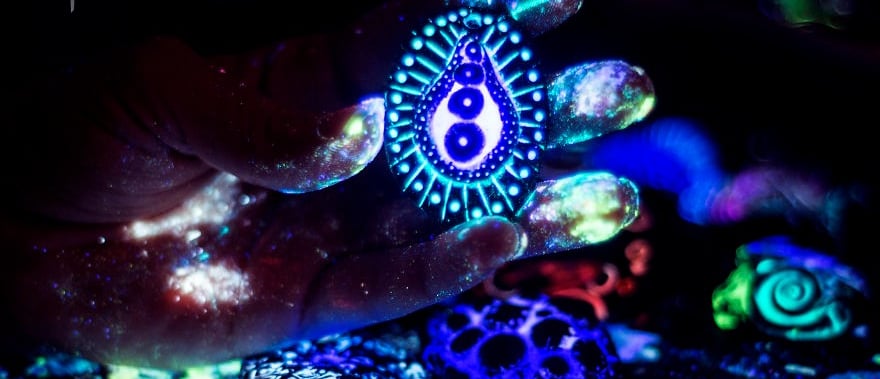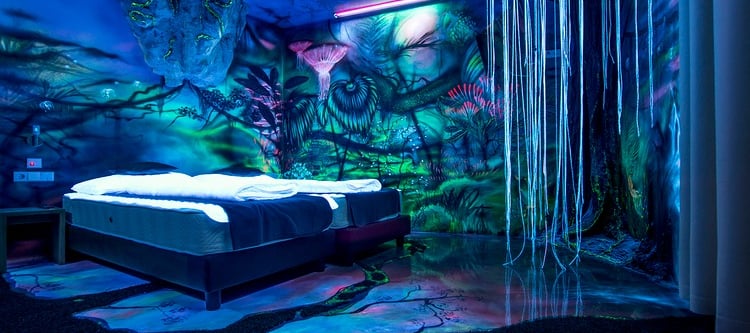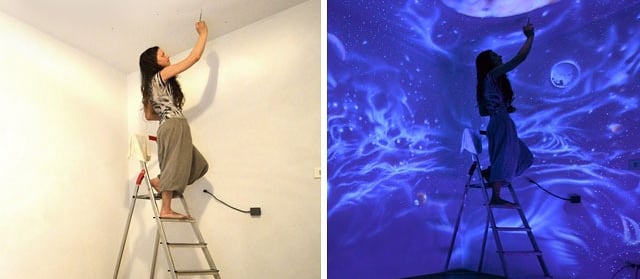Bogi Fabian
An exploration of the multidimensional art of Bogi Fabian, where darkness becomes a canvas and light reveals infinite dimensions.


The Origin of a Visionary: Bogi Fabian’s Early Life and Artistic Awakening
Bogi Fabian, born in Hungary and now recognized internationally, is an artist whose vision transcends the conventional boundaries of painting, sculpture, and installation. From a very young age, Fabian displayed an insatiable curiosity and a deep sensitivity to her surroundings. Raised in an environment where creativity was nurtured, she gravitated naturally toward artistic expression. Unlike traditional artists who rely solely on the visible spectrum, Fabian developed a unique fascination with invisible dimensions—a passion that would become central to her future work.
Her early artistic experiments were not confined to conventional mediums. Fabian began to explore the interplay between space, perception, and light. Rather than restricting her expression to two-dimensional canvases, she sought immersive formats—walls, ceilings, objects, even bodies. A self-taught artist in many respects, Fabian’s path was not dictated by formal education or academic art theories. Instead, her journey was deeply personal, introspective, and intuitive. This independence gave her the freedom to innovate, to blend media in unexpected ways, and to challenge established notions of art.
From adolescence onward, she became increasingly interested in luminescent materials, especially phosphorescent pigments that react to black light and darkness. This obsession eventually laid the foundation for her signature style: site-specific installations and glowing murals that transform in different lighting conditions. These artworks are not static; they evolve throughout the day, offering entirely distinct visual experiences in daylight, twilight, and total darkness. Such transformative art had rarely been seen before in contemporary Europe, and Fabian stood at the forefront of this emerging niche.
What distinguishes her even further is the philosophical underpinning of her work. Fabian views her art as a bridge between the visible and the invisible, the conscious and subconscious. Her installations are invitations to explore the universe, inner self, and the unknown. Whether evoking the vastness of space or the complexity of dreams, her art is suffused with a sense of cosmic wonder. The early chapters of Bogi Fabian’s artistic life thus lay the groundwork for a career that would redefine the relationship between light, space, and perception.
The Impact of Darkness: Reclaiming the Unseen in Contemporary Art
In an era dominated by bright screens, digital overexposure, and hyper-visibility, Bogi Fabian’s choice to work with darkness is both radical and restorative. Where most visual art seeks to be immediately apprehended—either through vibrant colors or dramatic contrast—Fabian’s installations often require patience, a dimming of lights, and a shift in internal tempo. She invites the viewer to slow down, to step into the unknown, and to allow the eyes to adjust, not just optically but emotionally. This is not art that demands attention through volume—it beckons quietly, through mystery.
This approach challenges the conventional gallery experience. Most of Fabian’s works cannot be adequately displayed in traditional white-walled spaces under sterile lighting. Her pieces need curated environments—rooms that can be darkened, black lights installed, and natural light carefully managed. As a result, much of her most celebrated work is commissioned for private homes, experiential hotels, therapeutic clinics, and immersive exhibitions where the environment can be customized to her vision. These unique demands have elevated her to cult status among architects, designers, and collectors seeking to push the boundaries of spatial design.
But the darkness in Fabian’s art is never void or oppressive. Instead, it becomes a threshold to revelation. The invisible becomes visible, the hidden is unveiled, and the ordinary transforms into something ethereal. In this sense, her work operates in symbolic opposition to the world’s emphasis on illumination. She reminds us that some truths are only found when we surrender to darkness—that beauty can dwell in the unseen.
Psychologically, this resonates deeply. Fabian’s art encourages introspection. Standing in one of her glowing environments is akin to entering a lucid dream or a meditative state. The absence of visual noise creates room for silence, and that silence can be transformative. This effect is not accidental; Fabian has spoken about her desire for her art to serve as a catalyst for inner exploration, healing, and renewal. Her use of cosmic imagery, for instance, is not merely decorative—it’s a symbolic reflection of inner space, of galaxies within the mind.
In this way, Bogi Fabian becomes not just an artist but a guide through the shadowlands—an architect of experience who uses darkness to teach us to see again. Her installations are portals, not products; moments of transcendence in a world too often bound by surface appearances. This vision places her in a unique category of contemporary artists, one where perception, environment, and philosophy converge into a single glowing gesture.
The Global Reach: Recognition, Collaborations, and Cultural Significance
Over the past decade, Bogi Fabian’s name has become synonymous with transformative, multidimensional art. Her projects span continents, and her installations now exist in homes, public venues, and institutions across Europe, Asia, and North America. What began as a personal exploration into the hidden language of light has evolved into a global movement, inspiring a new generation of artists to reimagine the role of darkness in artistic expression.
Fabian’s influence is especially pronounced in the fields of interior design, immersive theater, and experiential wellness. She has collaborated with architects to design luminous meditation rooms, worked with therapists to develop healing spaces for trauma patients, and partnered with educational institutions to create sensory learning environments. These collaborations highlight her deep understanding of art as a multisensory, therapeutic tool, capable of shifting not only mood but also consciousness.
One of her most significant contributions has been to the evolution of “glow art” as a legitimate fine art genre. While glow-in-the-dark materials were once relegated to novelty products or children’s toys, Fabian’s rigorous technique and philosophical depth have transformed these media into high art. She has proven that luminescent materials can be just as emotionally and intellectually potent as oil paint or marble—when wielded by a master hand.
Critics have praised her work for its synthesis of science and spirituality, noting that few contemporary artists are able to bridge these domains without slipping into cliché or abstraction. Her installations manage to feel both cosmic and intimate, technological and ancient. This is especially evident in her large-scale murals, which often depict galaxies, lunar landscapes, or oceanic voids that pulse with quiet emotion. For many, these spaces offer not just visual wonder, but a reprieve from the sensory overload of modern life.
Fabian’s popularity has also been boosted by the inherently photogenic nature of her installations. Social media has played a role in broadcasting her glowing galaxies to a global audience. Yet, even as images of her work circulate widely online, those who have experienced her pieces in person agree on one thing: no photograph can capture the living, breathing essence of a Bogi Fabian space. The experience must be felt. It is physical, emotional, and almost metaphysical—a quiet collision between self and cosmos.
Despite her growing fame, Fabian remains deeply committed to authenticity and purpose. She continues to self-produce many of her works, insisting on controlling every stage of the process—from material preparation to final installation. This hands-on approach reflects not only her perfectionism but also her belief that art is an intimate act, a sacred exchange between maker and viewer. It is this integrity that has secured her place as one of the most innovative and respected experiential artists of our time.
Latest Exhibitions
Bogi Fabian’s most recent exhibitions represent a compelling evolution of her vision, pushing her work into new thematic and technological territories. In 2023, she unveiled the highly acclaimed “Parallel Realms” in Vienna—a solo exhibition that transformed a gallery into a surreal constellation of glowing corridors, each representing a different state of consciousness. Daylight revealed minimalistic patterns, while ultraviolet light unveiled intricate cosmic architectures beneath the surface. The experience blurred the lines between dream, memory, and presence, prompting viewers to reconsider the nature of perception itself.
Later that year, in Amsterdam, she presented “Echoes of the Void”, a collaborative project with sound artists and neuroscientists. This multi-sensory installation combined glowing wall murals, vibration-responsive sculpture, and brainwave-reactive lighting. Participants wore EEG headsets, allowing the environment to shift in real time based on their neural activity. The result was an art space that did not merely respond to the body, but to the mind’s electrical signature—a deeply intimate experience that broke new ground in interactive art.
In early 2024, Fabian returned to Hungary for “Luminous Legacy”, a retrospective held in Budapest that showcased the evolution of her medium. This exhibition was notable for incorporating early sketches, raw pigment samples, and behind-the-scenes footage of her most ambitious installations. It provided a rare glimpse into the laborious process behind the glow, allowing audiences to appreciate the complexity and craftsmanship that define her oeuvre.
Currently, she is developing a long-term installation titled “The Hidden Spectrum”, set to be unveiled in Tokyo in late 2025. This ambitious project explores the visual language of electromagnetic waves beyond human perception. It aims to merge art, physics, and architectural design into a multi-level pavilion where visitors can walk through simulated light frequencies invisible to the naked eye. Using sensors, projection mapping, and phosphorescent surfaces, Fabian seeks to simulate a world beyond sight, challenging viewers to engage with the unknown.
These recent exhibitions confirm that Fabian is not content to rest on past successes. She continues to experiment, expand, and evolve, each project more ambitious than the last. With each exhibition, she reaffirms her status as a visionary artist redefining the future of immersive, light-based art.
Official Links
Website: www.bogifabian.com
Instagram: instagram.com/bogi.fabian
Facebook: facebook.com/BogiFabianArt
YouTube: youtube.com/@BogiFabian


Creating New Dimensions: The Artistic Philosophy Behind the Glow
As Bogi Fabian’s career evolved, her work became increasingly interdisciplinary, drawing from physics, metaphysics, psychology, and cosmology. Rather than producing decorative pieces, she creates immersive experiences that demand physical presence and emotional openness. Her installations are designed to be felt as much as seen—constructed to guide the viewer into a liminal space where the material and immaterial blur. Fabian’s signature style, often referred to as “light-responsive art”, encompasses painting, interior design, sculpture, and augmented environments.
One of the defining elements of Fabian’s work is her manipulation of phosphorescent and UV-reactive materials. These are not merely technical flourishes; they are integral to her conceptual framework. Light becomes a medium, darkness becomes a canvas, and visibility itself becomes dynamic. A single mural can have multiple identities depending on how it is lit—natural daylight reveals one version, black light another, and complete darkness yet another. This artistic multiplicity is deeply symbolic of Fabian’s philosophical beliefs about duality, time, and the transient nature of perception.
The influence of cosmology and the infinite is readily apparent. Stars, galaxies, nebulae, planetary systems—Fabian renders these astronomical forms not merely with technical precision but with a profound sense of spiritual reverence. She invites the viewer to contemplate not just the physical universe, but also the psychic and metaphysical space we inhabit. For her, the celestial is not out there, but within us. Each glowing planet or spiral galaxy becomes a mirror of the subconscious, reflecting archetypes and dreams buried deep within the human psyche.
At the core of Fabian’s philosophy is the notion that reality is layered and subjective, that there are hidden truths beneath surface appearances. This belief has led her to create entire rooms, corridors, and ceilings that respond to changes in light and perspective, producing a temporal, emotional, and cognitive shift in the viewer. Her murals can transform a child’s bedroom into a galactic haven, or a sterile corridor into a forest of glowing dreams. She reimagines space not as a passive backdrop but as a transformative medium capable of altering consciousness.
Material and Process: The Alchemy of Light and Space
What makes Bogi Fabian’s work so mesmerizing is not only her vision but the rigorous technique and experimentation behind each project. Creating an immersive artwork that reveals itself in multiple lighting conditions is an immensely complex endeavor, requiring an unusual blend of artistic intuition, chemical knowledge, and architectural awareness. The process is both scientific and spiritual, each piece undergoing phases of testing, calibration, and refinement until the final result evokes the desired emotional and visual impact.
Fabian works with a vast array of custom-developed materials, many of which are sourced from specialized chemical laboratories. Her use of glow-in-the-dark pigments, fluorescent inks, UV-reactive paints, and phosphorescent minerals allows her to manipulate how surfaces absorb and emit light. These substances are not commercially standard; in many cases, Fabian must modify or combine compounds to achieve the unique glow, longevity, and color gradient she envisions. This makes each project an exercise in material alchemy—a term she often uses to describe her artistic process.
Another defining feature of her methodology is the site-specific nature of her murals and installations. Fabian does not work on pre-assembled canvases. Instead, she enters the space, analyzes its geometry, function, and ambient lighting, and constructs an artwork that interacts intimately with its environment. This can involve painting directly on walls, ceilings, furniture, or structural features, integrating them into the final composition. The architectural space is not just a container for the art—it becomes the art itself.
In some of her most celebrated works, Fabian has used hidden layers to create what she calls "time paintings": murals that change character across morning, noon, dusk, and night. These pieces require careful synchronization of natural and artificial lighting, often involving coordination with interior designers, electricians, and engineers. The result is a space that breathes and evolves—a living artwork that offers fresh experiences with each visit. To witness these transformations in person is to be reminded of the ever-changing nature of perception and the fluidity of time itself.
Beyond murals and spatial installations, Fabian also explores body art, sculpture, and digital animation, often blending these media into singular hybrid forms. Her body painting, for example, transforms human skin into cosmic topographies, glowing galaxies, or lunar textures, effectively turning the body into a performance canvas. These temporary works are often documented through photography or video, but their true impact lies in their ephemeral nature—a reflection of Fabian’s belief in the impermanence of all things visible.






Awarded with the Highest Distinction
Bogi Fabian was selected for the Excellence Award for her groundbreaking fusion of art, science, and emotion, and for her commitment to creating immersive spaces that transcend the visual and touch the soul. Her work redefines how we perceive space, light, and self, making her a true innovator in contemporary experiential art.






